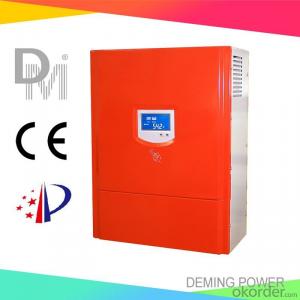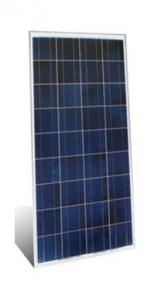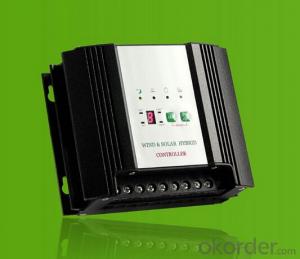MPPT Solar Charge Controller 96V 100A with best price for solar power system
- Loading Port:
- Qingdao
- Payment Terms:
- TT OR LC
- Min Order Qty:
- 1 PCS
- Supply Capability:
- 1000 PCS/month
OKorder Service Pledge
OKorder Financial Service
You Might Also Like
Properties of the solar charge controller
1. Design for off-grid solar power system.
2. Applicable to different kinds of batteries.
3. Adopts MPPT technology (Maximum Power Point Tracking). The advanced tracking algorithm make the solar module operate at ideal voltage which the solar modules can produce the maximum available power.
4. Modular design with simple structure and easy maintenance.
5. Automatic power control function.
6. LCD display: Solar panel current, solar panel voltage, solar panel power, battery group voltage, charge current.
7. Perfect protection function: Solar reverse charge protection, Solar reverse connection protection, Battery reverse connection protection, Battery overcharge protection, Battery over current protection etc ,thus the system has higher reliability.
Technical parameters of the solar charge controller
Model | 96V100A | |||||
Battery group rated voltage | 96Vdc | |||||
PV Rated current | 100A | |||||
PV open circuit voltage | 400V | |||||
PV Max. power | 9600Wp | |||||
Input PV module road number | 1 | |||||
Function | MPPT charge mode, auto stop charge, auto recharge voltage; Protection: connecting contrary, over current, short circuit, over heat etc. | |||||
Display mode | LCD | |||||
Display content | solar panel voltage, solar panel current, solar panel power, battery voltage, charge current | |||||
MPPT DC voltage range | 80-116Vdc | |||||
Floating Charge Voltage (adjustable) | 110Vdc | |||||
Stop charge voltage | 116Vdc±1% | |||||
Recharge voltage | 108V±1% | |||||
Voltage drop between PV and battery | 1.5V | |||||
Max itself power consumption | 100mA-150mA | |||||
Work environment temperature | -30-60°C | |||||
Relative humidity | 90% No condensation | |||||
Applicable altitude | 3000m The rated power should be reduced when it is higher than 2000m | |||||
Noise (1m) | 40dB | |||||
Degree of protection | IP20(Indoor) | |||||
Cooling method | Forced air cooling | |||||
*Communication interface (optional) | RS485/USB/GPRS/Ethernet | |||||
*Temperature compensation(optional) | -4mv/°C/2V,-35°C~+80°C,Accuracy:±1°C | |||||
Product size (mm) | 620*500*180mm | |||||
Product Weight(kg) | 32kg | |||||
*Above parameter only for reference. Could be custom made to user specifications.
- Q:How does a solar controller handle battery under-temperature protection?
- A solar controller handles battery under-temperature protection by monitoring the temperature of the battery and adjusting the charging parameters accordingly. If the battery temperature drops below a certain threshold, the controller reduces the charging current to prevent damage to the battery. This helps to maintain the battery's performance and prolong its lifespan.
- Q:How does a solar controller handle shading on solar panels?
- A solar controller handles shading on solar panels by using Maximum Power Point Tracking (MPPT) technology. This technology allows the controller to constantly monitor the voltage and current output of the solar panels, adjusting the load to ensure that the panels operate at their maximum power output despite shading. By dynamically optimizing the voltage and current, the solar controller minimizes the impact of shading and maximizes the overall energy generation of the solar panels.
- Q:Can a solar controller be used with a generator or grid power as a backup?
- Yes, a solar controller can be used with a generator or grid power as a backup. A solar controller regulates the charging and discharging of batteries in a solar power system, and it can seamlessly integrate with a generator or grid power source when additional or backup power is needed.
- Q:Can a solar controller be used with solar panel cooling systems?
- Yes, a solar controller can be used with solar panel cooling systems. A solar controller is responsible for regulating the flow of power from the solar panels to the batteries or grid, and it also monitors and protects the batteries from overcharging or discharging. In the case of solar panel cooling systems, the solar controller can be used to power and control the cooling mechanism. This ensures that the solar panels are kept at optimal temperatures, which can improve their efficiency and prolong their lifespan. By using a solar controller, the cooling system can be operated effectively and efficiently, maximizing the output of the solar panels.
- Q:What is the maximum number of load control timers supported by a solar controller?
- The maximum number of load control timers supported by a solar controller can vary depending on the specific model and manufacturer. However, many solar controllers typically support multiple load control timers, ranging from around 10 to 30 timers or even more in some advanced models.
- Q:How does a solar controller prevent short circuits?
- A solar controller prevents short circuits by monitoring and regulating the flow of electrical current from the solar panels to the batteries. It has built-in mechanisms such as fuses and circuit breakers that automatically trip or disconnect the circuit in case of a short circuit, preventing any potential damage or overheating.
- Q:Can a solar controller be used with a solar-powered security camera system?
- Yes, a solar controller can be used with a solar-powered security camera system. A solar controller regulates the flow of power from the solar panels to the battery, ensuring optimal charging and preventing overcharging or damage. Therefore, it is essential for maintaining the efficiency and longevity of a solar-powered security camera system.
- Q:Can a solar controller be used with a solar-powered boat or marine system?
- Yes, a solar controller can be used with a solar-powered boat or marine system. A solar controller is essential in regulating the charging process of the solar panels and managing the power output to the batteries. It ensures that the batteries are not overcharged or damaged, thereby optimizing the performance and longevity of the boat or marine system.
- Q:How do I monitor the performance of a solar controller?
- To monitor the performance of a solar controller, you can follow these steps: 1. Check the controller's display: Most solar controllers have built-in displays that provide real-time information about the system's performance. This display usually shows parameters like battery voltage, charging current, and load usage. By regularly checking this display, you can keep an eye on the controller's performance. 2. Analyze battery charge status: Solar controllers are responsible for charging batteries, so monitoring the battery's charge status can give you insights into the controller's performance. Use a battery monitor or a voltmeter to measure the battery voltage regularly. If the voltage remains within the recommended range, it indicates that the solar controller is effectively charging the battery. 3. Evaluate charging efficiency: Assessing the charging efficiency helps you determine how well the solar controller is converting solar energy into usable power. Measure the current being delivered by the controller to the battery using a suitable ammeter. Compare this value to the solar panel's rated current to gauge the controller's charging efficiency. 4. Monitor load usage: Solar controllers also manage the power distribution to the connected loads. Keep an eye on the load usage to ensure the controller is providing power as required. If you notice irregularities or inconsistencies in load usage, it may indicate a performance issue with the solar controller. 5. Utilize monitoring devices: In addition to the built-in display, you can enhance monitoring using external devices. Some solar controllers offer compatibility with remote monitoring systems or data loggers. These devices allow you to track the performance of the controller remotely and analyze historical data. By logging and analyzing the data, you can identify any performance trends or anomalies. By employing these monitoring techniques, you can effectively assess the performance of a solar controller and promptly address any issues that may arise.
- Q:What is the role of a remote monitoring system in a solar controller?
- The role of a remote monitoring system in a solar controller is to collect and analyze data from the controller, panels, and other components of the solar system. It allows for real-time monitoring of the system's performance and provides important information on energy production, battery status, and any potential issues or malfunctions. This enables remote troubleshooting, efficient maintenance, and optimization of the solar system's efficiency and overall performance.
1. Manufacturer Overview |
|
|---|---|
| Location | |
| Year Established | |
| Annual Output Value | |
| Main Markets | |
| Company Certifications | |
2. Manufacturer Certificates |
|
|---|---|
| a) Certification Name | |
| Range | |
| Reference | |
| Validity Period | |
3. Manufacturer Capability |
|
|---|---|
| a)Trade Capacity | |
| Nearest Port | |
| Export Percentage | |
| No.of Employees in Trade Department | |
| Language Spoken: | |
| b)Factory Information | |
| Factory Size: | |
| No. of Production Lines | |
| Contract Manufacturing | |
| Product Price Range | |
Send your message to us
MPPT Solar Charge Controller 96V 100A with best price for solar power system
- Loading Port:
- Qingdao
- Payment Terms:
- TT OR LC
- Min Order Qty:
- 1 PCS
- Supply Capability:
- 1000 PCS/month
OKorder Service Pledge
OKorder Financial Service
Similar products
New products
Hot products
Hot Searches
Related keywords
































